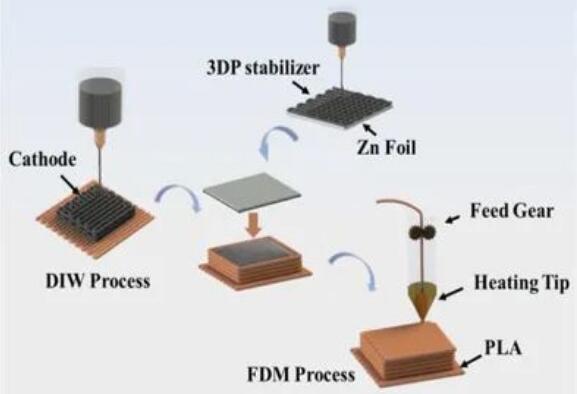Recently, Wu Zhongshuai's team, a researcher at the Dalian Institute of Chemical Physics, Chinese Academy of Sciences, has proposed a new strategy for building fully printed customizable aqueous zinc ion hybrid capacitors through two 3D printing methods: ink direct-write forming and fused deposition molding.
Using this strategy, the team successfully constructed a high surface capacity positive electrode with a graded porous structure and a zinc metal negative electrode without a dendritic stable structure, and prepared a high specific energy, long cycle stable zinc ion hybrid capacitor. The research results were published in Advanced Energy Materials.

The research team at Dalian Research published the paper under the title 'All 3D Printing Shape-Conformable Zinc Ion Hybrid Capacitors with Ultrahigh Areal Capacitance and Improved Cycle Life'.
Link to the paper: https://doi.org/10.1002/aenm.202200341
Positive and negative electrodes, electrolyte, package fully printed
Zinc ion electrochemical energy storage devices have attracted a lot of attention due to their low redox potential, high theoretical capacitance and high safety. Zinc ion hybrid capacitors effectively combine the advantages of zinc ion batteries and supercapacitors, achieving both high energy density and high power density. However, aqueous zinc ion hybrid capacitors still suffer from low surface capacity, zinc dendrite growth and device shape factor limitations, which hinder their further development in practical applications.
The team constructed fully printed zinc ion hybrid capacitors, including porous microlattice positive electrodes, dendrite free zinc metal negative electrodes, gel electrolytes and plastic encapsulation by two 3D printing methods, ink direct writing forming and fused deposition moulding. Among them, the metal-stabilised structure printed on the zinc negative electrode effectively inhibits the growth of zinc dendrites while extending the cycle life of the zinc ion hybrid capacitor. The graded porous positive electrode increases the area loading of the active material, thereby increasing the area capacitance of the zinc ion hybrid capacitor.
Combined with fused deposition moulding 3D printing technology, the team has constructed zinc ion hybrid capacitors based on a packaging structure that matches the electrode structure, successfully realising fully 3D printed zinc ion hybrid capacitors with customisable shapes.
This work demonstrates the potential of 3D printing technology for the application of customisable energy storage devices.

